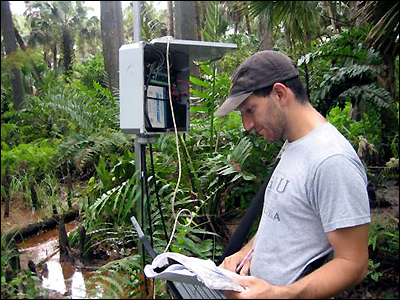Linking River, Floodplain, and Vadose Zone Hydrology in a Coastal Wetland Impacted by Saltwater Intrusion: The Loxahatchee River (Florida, USA)
Participants: David Kaplan, Amanda Mortl, Rafael Muñoz-Carpena, Yuncong Li (UF); Yongshan Wan, Marion Hedgepeth, Fawen Zheng (SFWMD); Dick Roberts, Rob Rossmanith (FPS)
Timeline: September 2004 - September 2008 (Field Study), May 2008 - May 2010 (Data Analysis and Modeling)
Funding Agencies: South Florida Water Management District (SFWMD)
Project Summary
Floodplain forests provide unique ecological structure and function, which are often degraded or lost when watershed hydrology is modified. Restoration of impacted ecosystems requires an understanding of surface water, groundwater, and vadose (unsaturated) zone hydrology in the floodplain, however most wetland restoration efforts focus on monitoring and modeling only surface water processes. Soil moisture and porewater salinity are of particular importance for seed germination and seedling survival in systems impacted by saltwater intrusion, but are difficult to monitor and often overlooked.
This study contributes to the understanding of floodplain hydrology in one of the last bald cypress (Taxodium distichum [L.] Rich.) floodplain swamps in southeast Florida (USA) by investigating groundwater, soil moisture, and porewater salinity dynamics in the floodplain of the Loxahatchee River, where reduced freshwater flow has led to saltwater intrusion and a transition to salt-tolerant, mangrove-dominated communities. Twenty-four dielectric probes measuring soil moisture and porewater salinity every 30 minutes were installed along two transects - one in an upstream, freshwater location; the other in a downstream tidal area. Additionally, a network of twelve groundwater wells was developed along five transects that encompass a gradient of floodplain conditions from upstream freshwater areas downstream to the estuary.

Data collected over four years quantified the spatial variability and temporal dynamics of groundwater and vadose zone hydrology and showed that soil moisture can be closely predicted based on river stage and topographic elevation (coefficient of efficiency = 0.83). Porewater salinity rarely exceeded tolerance thresholds for bald cypress upstream, but did so in some downstream areas, fully explaining observed vegetation changes for the first time.
Dynamic factor analysis (DFA), a multivariate times series analysis technique, proved useful for studying interactions among experimental times series and other hydrological variables in the watershed and helped us develop dynamic factor models (DFMs) of groundwater level, salinity, and soil moisture. The results offer a methodological and analytical framework for floodplain monitoring in locations where restoration success depends on groundwater and vadose zone hydrology and provide relationships for evaluating proposed management scenarios for the Loxahatchee River.
Project Impacts
Research findings are being used to guide management and restoration planning for the river.
Resource Links
- Jonathan Dickinson State Park - Florida Park Service
- Loxahatchee River District
- Loxahatchee River Paddling Trail
- SFWMD Loxahatchee
Publications
Refereed Publications
- Kaplan, D., R. Muñoz-Carpena, and A. Ritter. 2010. Untangling complex shallow groundwater dynamics in the floodplain wetlands of a southeastern U.S. coastal river. Water Resources Research 46:W08528, doi:10.1029/2009WR009038.
- Kaplan, D., R. Muñoz-Carpena, Y. Wan, M. Hedgepeth, F. Zheng, R. Roberts, and R. Rossmanith. 2010. Linking river, floodplain, and vadose zone hydrology to improve restoration of a coastal river impacted by saltwater intrusion. Journal of Environmental Quality 39(5):1570-1584, doi: 10.2134/jeq2009.0375.
- Kaplan, D. and R. Muñoz-Carpena. 2010. Complementary effects of surface water and groundwater on soil moisture dynamics in a degraded coastal floodplain forest. Journal of Hydrology, doi:10.1016/j.jhydrol.2010.12.019 (in press).
- Mortl, A., R. Muñoz-Carpena, D. Kaplan. 2010. Calibration of a combined dielectric probe for soil moisture and porewater salinity measurement in three southeastern (USA) coastal floodplain soils. Geoderma, doi:10.1016/j.geoderma.2010.12.007 (in press)
- Kaplan, D., R. Muñoz-Carpena, G. Kiker, Y. Wan. An ecohydrological model to assess the potential for restoration success in a degraded bald cypress (Taxodium distichum [L.]) floodplain swamp (in preparation/submision)
Proceedings
- Kaplan, D., R. Muñoz-Carpena, Y.C. Li, Y. Wan, M. Hedgepeth, R. Roberts. 2008. Altered Hydroperiod and Saltwater Intrusion in the Bald Cypress Swamps of the Loxahatchee River. In: Proceedings of the 20th Salt Water Intrusion Meeting, Naples, Florida, June 2008. pp. 109-112.
- Kaplan, D. R. Muñoz-Carpena, A. Mortl, Y.C. Li. 2007. Humedad y salinidad del suelo en un pantano de ciprés calvo (Taxodium distichum) impactado por intrusión de agua salina. In: J.V. Giráldez Cervera and F.J. Jiménez Hornero (eds.). Estudios de la Zona No Saturada del Suelo Vol. VIII. pp. 257-266. Cordoba (Spain). ISBN: 84-690-7893-8
Reports
- Muñoz-Carpena, R., D. Kaplan and A. Ritter. 2009. Advanced Data Analysis of Shallow Groundwater Dynamics in the Loxahatchee River Floodplain[8.77MB]. Final Data Analysis Report to the South Florida Water Management District-Coastal Ecosystems Division, SFWMD Identifier: PO4500030399. November 2009. University of Florida: Gainesville.
- Muñoz-Carpena, R., D. Kaplan and F.J. Gonzalez. 2008. Groundwater Data Processing and Analysis for the Loxahatchee River Basin[13.7MB]. Final Project Report to the South Florida Water Management District-Coastal Ecosystems Division, SFWMD Identifier: 4500020860. August 2008. University of Florida: Gainesville.
Presentations & Posters
- Kaplan, D., R. Muñoz-Carpena, and A. Ritter. 2009. Linking saltwater intrusion with impacts to bald cypress (Taxodium distichum) swamp in the floodplain of the Loxahatchee River using dynamic factor modeling. Annual Meeting of the American Society of Agricultural and Biological Engineers, Florida Section, July 2009, Daytona Beach, FL.
- Kaplan, D., R. Muñoz-Carpena, and A. Ritter. 2009. Dynamic factor modeling of floodplain hydrology in a south Florida bald cypress (Taxodium distichum) swamp. American Water Resources Association Conference on Managing Water Resources and Development in a Changing Climate, May 2009, Anchorage, AK.
- Kaplan, D. 2008. Effects of restoration scenarios on the floodplain of the Northwest Fork of the Loxahatchee River. Poster presentation at the Greater Everglades Ecosystem Restoration Conference, July 2008, Naples, FL.
- Kaplan, D. 2008. Soil moisture and salinity dynamics in the floodplain of the Northwest Fork of the Loxahatchee River. Fourth Biennial Loxahatchee River Science Symposium, May 2008, Jupiter, FL.
- Kaplan, D. 2008. Soil moisture and salinity dynamics in a freshwater bald cypress (Taxodium distichum) swamp impacted by saltwater intrusion. Poster presentation at the University of Florida Water Institute Symposium on Sustainable Water Resources, February 2008, Gainesville, FL.
This page was last updated on July 13, 2019.